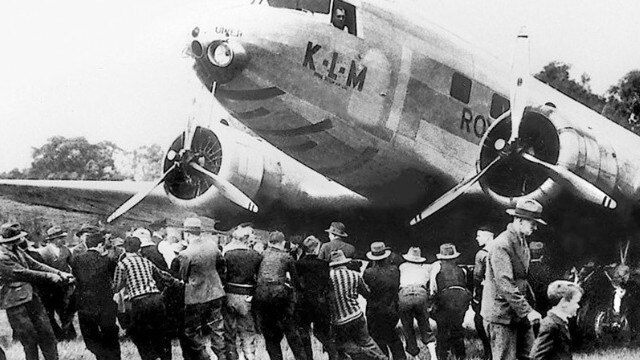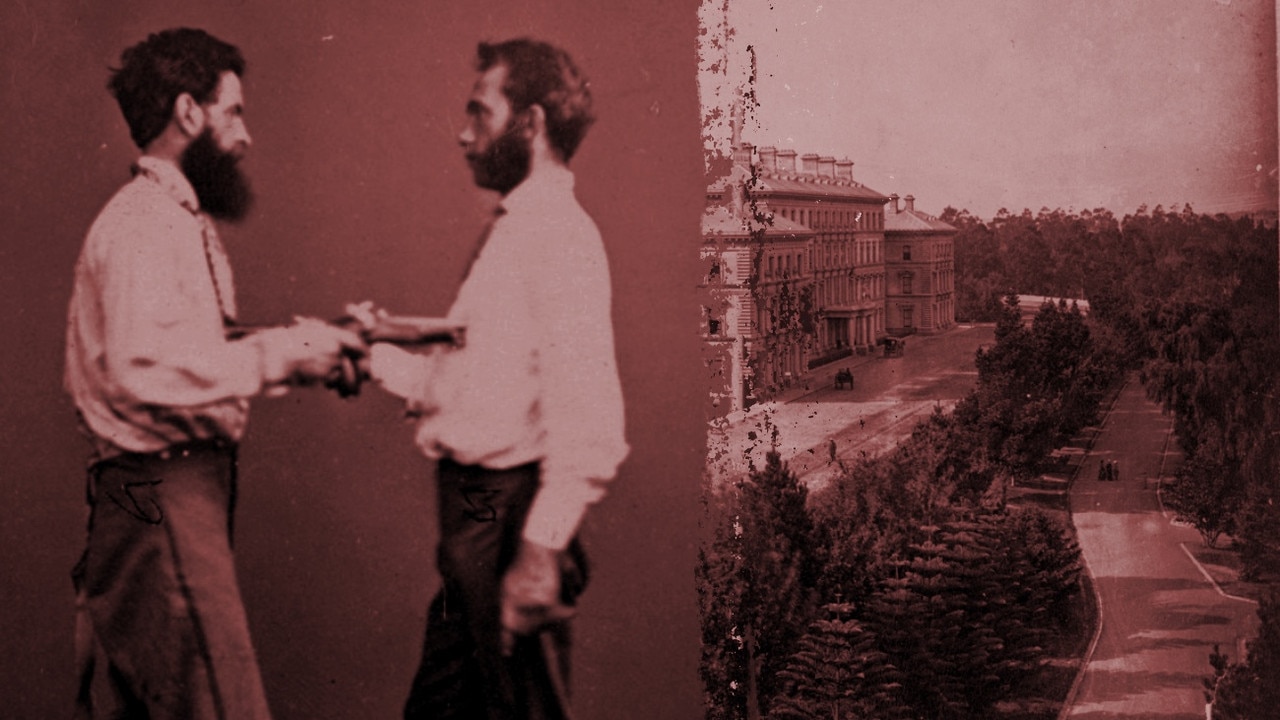The chocolate king, the air race and the hero town
THE man whose gave us Freddo Frogs and Cherry Ripes also gave the world a global air race from England to Flemington racecourse. But when a plane became lost mid-race, one Aussie town came to the rescue.

Melbourne
Don't miss out on the headlines from Melbourne . Followed categories will be added to My News.
MELBOURNE confectionery millionaire Sir MacPherson Robertson was behind a tribute for Victoria’s centenary that was too sweet for the world’s aviators to resist.
The man whose gave us Freddo Frogs and Cherry Ripes also gave the world the MacRobertson Air Race.
The race was devised by Melbourne Lord Mayor Sir Harold Gengoult and run by the Royal Aero Club but MacPherson Robertson stumped up the £15,000 in prize money.
HOW FLYING HAS CHANGED IN 60 YEARS
Twenty teams entered the race, which began at Royal Air Force base Mildenhall in England and finished at Melbourne’s Flemington Racecourse.
To reach Melbourne, 18,000 kilometres away, the racers had to make compulsory stops in Baghdad, the Indian city of Allahabad, Singapore, Darwin and Charleville but otherwise could use any aircraft, any number of crew members and any route they chose.

One team from the royal Dutch airline KLM took a unique approach, with a crew of four people and three paying passengers — the only aircraft in the race to take passengers along for the ride.
Its near-new Douglas DC-2, called Uiver (Dutch for Stork) was an all-metal aircraft with retractable landing gear and a maximum speed of just under 340km/h.
The racers took off from RAF Mildenhall at dawn on Saturday, October 20, 1934.
The Uiver’s crew, led by Captain R.D. Parmentier, followed a route similar to that it took to fly from Amsterdam to Batavia in the Dutch East Indies (now Jakarta, Indonesia), which was about 1600km longer than the official race route.
It carried mail and dropped off passengers along the way.
But its most dramatic moment came in the final leg of the race, between Charleville and Melbourne, while it was a contender for victory.
The year 1934 was a particularly wet one in eastern Australia thanks to a La Nina. Killer storms and floods swept through Melbourne in late October and early November 1934, claiming more than 30 lives.
Weather proved to be the Uiver’s Achilles heel. As it crossed inland NSW on the night of October 23, it flew into a savage electrical storm and the crew became hopelessly lost.
The storm interfered with the plane’s navigation and wireless communications, and it way off course.
The intended route from Charleville was via Cunnamulla, passing east of Bourke to Hillston, then over Yarrawonga and Seymour to Melbourne.
Signallers at RAAF Laverton called on people in NSW towns to listen for any signs of it in the air.

The crew tried to head for the boast but was unable to navigate through clouds to cross the Great Dividing Range.
Heading further south instead, the plane was heard over Goulburn, Wagga Wagga and Albury. Further south at Tawonga, near Bright, farming families heard the aircraft and contacted the local ABC station, then known as 2CO.
Running low on fuel, the crew steered the aircraft northeast, and it was heard over Tallangatta, then turned towards Albury.
The sleepy little border town sprang to life in the dead of that stormy night.
Arthur Newnham, an announcer at 2CO, broke out of regular programming at 12.54am to advise listeners of the Uiver’s plight, and directed anyone with motor cars to head to the Albury Racecourse to light a safe path for the Uiver to land.
Air race organisers contacted Clifton Mott, a newspaper sub-editor in town, instructing him to find a way to use lights to signal to the aircraft.
He enlisted the help of Lyle Ferris, Albury’s municipal electrical engineer, and Reg Turner, the district postal inspector.
Turner’s knowledge of Morse code and Ferris’ electrical expertise allowed them to switch the town’s lights on and off to spell out A-L-B-U-R-Y to the stricken aircraft.
At least 80 motorists came out to the racecourse to use their headlights as landing lights for the Uiver.
Over Tallangatta, the Uiver turned for Albury.
The aircraft circled the racecourse twice, dropping two flares on parachutes to assess conditions, before landing safely in the racecourse’s vast infield at 1.17am, stuck fast in deep mud.
Arranged by the local mayor Alf Waugh, a team of around 300 people gathered at the racecourse at daybreak to pull the Uiver free of the mud and allow the crew to continue the race.
The crew of the Uiver completed the race that day, arriving 19 hours behind the winning aircraft thank to its unscheduled layover in Albury.

The winning aircraft was the purpose-built De Havilland Comet Grosvenor House flown by British aviators Charles William Anderson Scott and Thomas Campbell Black.
Still, the Uiver finished second overall and won the handicap prize, proving that long-haul international flights could be safe and comfortable.
Albury’s role in the rescue of the Uiver was a significant boost to Albury, a town left shocked and demoralised seven weeks earlier following the discovery of the body of a murdered woman known as the Pyjama Girl beside a road west of the town.
It also prompted an outpouring of goodwill from the Dutch people.
Messages of thanks were broadcast to Albury from The Netherlands.
KLM donated £200 to the Albury Hospital, while Cr Waugh was awarded a Dutch noble title, the Officer of the Order of Orange Nassau, on the approval of Dutch King George V, along with all four Dutchmen in the KLM crew.
A Dutch delegation later visited Albury to present gifts to people who were significant in the rescue of the Uiver. Arthur Newnham, for example, was given a cane with a silver top and a silver cigarette case.
A silver replica of the Uiver, complete with hatch doors that opened and a wingspan of about 60cm, was presented to the City of Albury by the Dutch government in 1936.
Many of these items, other artefacts including one of the parachutes dropped from the Uiver and a ticket from the air race flight are at the Albury Library Museum. Details of the collection are here.
The Dutch government struck four plaques in relation to the rescue. Three are in Albury — at the museum, the racecourse and the airport, with a fourth in The Netherlands.
Albury Airport also has a rare Douglas DC-2 replica of the Uiver as part of a memorial to the rescue. There is a public appeal for its restoration.
The Uiver’s rescue and its contribution to the advancement of international aviation through the air race is still commemorated on the KLM website.
Sadly, the Uiver’s days were numbered despite the rescue.
On December 20, 1934, less than two months after Albury rallied to save it, the Uiver crashed in the Iraqi desert on a flight to Batavia, killing all seven people on board.


